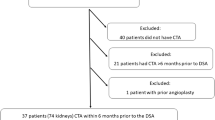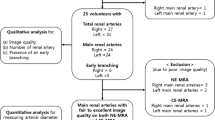Abstract
Purpose.
The purpose of this study was to establish the diagnostic value of multidetector–row computed tomography (MDCT) angiography compared with digital subtraction angiography (DSA) for detection and quantification of both main and accessory renal artery stenosis in patients with secondary hypertension.
Materials and methods.
Fifty consecutive patients scheduled for DSA were considered candidates for MDCT angiography. In all patients, MDCT angiography of the abdominal aorta was performed before DSA. For the purpose of interpretation, the arteries were separately interpreted either with DSA or MDCT angiography in order to provide qualitative and quantitative information. For qualitative evaluation, one experienced reader graded the opacification of renal arteries as excellent, good or poor; for quantitative evaluation, MDCT and DSA were independently evaluated for the number of renal arteries and the presence, location and degree of stenosis in random order by three readers. On the basis of consensus readings, calculations of sensitivity, specificity, accuracy, positive predictive value (PPV) and negative predictive value (NPV) for detection of degree of stenosis were made by using DSA findings as the standard of reference. Interobserver variability was also assessed.
Results.
With regard to qualitative analysis, arterial enhancement was considered excellent in 39 patients and good in 11. For quantitative analysis, 73 arteries were classified as normal with DSA. Although 72 of these were also classified as normal with CT angiography, one was overestimated by one grade; at DSA, 16 arteries were classified as moderately stenotic; in two arteries, there was an overestimation of one grade. Perfect correlation was achieved for the diagnosis of occlusion. In two patients, all three readers detected multiple severe stenoses on both modalities, with a “string–of–beads” appearance typical of fibromuscular dysplasia. Accessory arteries were correctly identified as such by all three readers on either DSA or MDCT. Levels of sensitivity, specificity and accuracy regarding degree of stenosis were 100%, 98.6% and 96.9%, respectively, with PPV and NPV of 97.6% and 100%, respectively. When we considered significant arterial stenosis (50%–100% luminal narrowing), sensitivity, specificity and accuracy were 100%, 97.3% and 97.8%, respectively, with a PPV and NPV of 98.2% and 97.8%, respectively. For all observers, interobserver agreement was almost perfect (k=0.81–1) for both MDCT and DSA, with a k value between 0.82 and 0.95.
Conclusions.
MDCT angiography is very accurate and robust, even for the assessment of renal artery stenosis, and has the potential to become a viable substitute, in most cases, for diagnostic catheter–based DSA.
Similar content being viewed by others
Author information
Authors and Affiliations
Corresponding author
Rights and permissions
About this article
Cite this article
Fraioli, F., Catalano, C., Bertoletti, L. et al. Multidetector–row CT angiography of renal artery stenosis in 50 consecutive patients: prospective interobserver comparison with DSA. Radiol med 111, 459–468 (2006). https://doi.org/10.1007/s11547-006-0042-3
Received:
Accepted:
Published:
Issue Date:
DOI: https://doi.org/10.1007/s11547-006-0042-3




